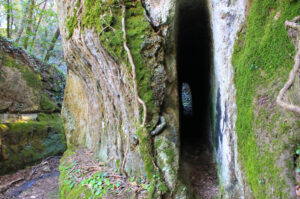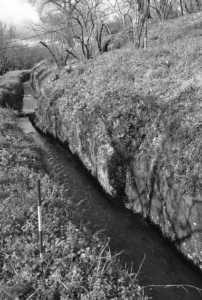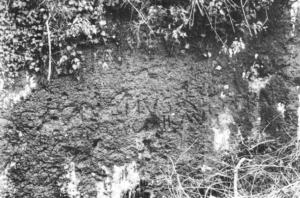Prata of Corchiano
Categories: Utilization of water and wind power; Drystone terracing in agriculture.
Historical context: The Prata of Corchiano represents a remarkable example of ancient agricultural engineering and irrigation systems. The location of the hydraulic work near the route of the road Amerina confirms the central role that the road network played in the reorganization of the territories conquered while suggesting a planned and comprehensive intervention of agrarian reorganization.
The systems of agricultural exploitation, linked to the need to obtain an adequate level of irrigation, seem recognizable in the Corchiano plant which at present constitutes the only archaeological evidence of the presence of similar installations.
This strategic positioning near the Amerina road underscores Corchiano’s historical significance as a hub of agricultural activity and innovation in ancient times. It reflects a concerted effort by ancient civilizations to harness water resources and optimize land usage, shaping the landscape and fostering agricultural productivity in the Ager Faliscus region.
Dating back to ancient times, these meadows, or “Prata,” were essential for sustaining high-quality pastures and crops in the Ager Faliscus region.
Form – main architectural features: The Prata of Corchiano comprises a complex system of irrigation basins, locks, dams, lateral channels, and drainage tunnels. The engineering solutions employed in its construction demonstrate the sophisticated understanding of water distribution and land arrangement by ancient farmers. The irrigation basins were strategically designed to ensure a constant water supply to the fields while effectively draining excess water to prevent stagnation and flooding.

https://www.tusciaup.com/opere-idrauliche-antiche-a-corchiano/131083
Function: The primary function of the Prata of Corchiano was to support agricultural activities by providing irrigated land for cultivation. The irrigation system allowed for the efficient distribution of water to the fields, promoting the growth of high-quality meadows and pastures. The controlled regulation of water flow through locks and dams ensured that the agricultural land received a consistent water supply, vital for crop growth and livestock grazing. Additionally, the drainage tunnels facilitated the removal of excess water, preventing waterlogging and soil erosion.

Unknown author. (n.d.).
Lessons for sustainability: The Prata of Corchiano offers valuable lessons for sustainability in agriculture and water management. The ancient irrigation systems employed in its construction highlight the importance of efficient water distribution and land utilization for optimizing agricultural productivity.
The use of natural topographical features and innovative engineering solutions demonstrates how ancient civilizations adapted to local environmental conditions to sustainably manage water resources and enhance agricultural yields. These historical insights can inform modern-day approaches to sustainable farming practices and environmental conservation.
Cultural heritage and tourism: As a unique archaeological site, the Prata of Corchiano holds significant cultural heritage value. The inscription found on the tuff, attributing the creation of the Prata to “C(aius) EGNATIUS SER(vii?) F(ilii) PRATA FACIUNDA COIRAVIT,” meaning “Caio Egnatio son of Servio supervised the creation of the prata”, adds to its historical significance.

The site attracts tourists, historians, and archaeologists interested in ancient agricultural practices and hydraulic engineering. Guided tours and educational programs provide visitors with insights into the rich agricultural history of the region and the innovative techniques employed by ancient farmers.
Preservation efforts ensure that the Prata of Corchiano continues to be appreciated as a tangible link to the agricultural heritage of Ager Faliscus.
In conclusion, the Prata of Corchiano stands as a testament to ancient agricultural ingenuity, showcasing sophisticated irrigation systems that sustained crops and pastures in the Ager Faliscus region.
With its intricate network of basins, locks, and tunnels, this historical site highlights the strategic importance of water management in optimizing agricultural productivity. Its inscription attributing its creation adds a compelling historical dimension, enriching our understanding of ancient farming practices.
Today, the Prata remains a valuable heritage site, offering insights into sustainable agriculture and serving as a link between past traditions and modern-day challenges.
Location: Corchiano, Lazio – Italy
Prata of Corchiano – Italy
Sources
Orlandi, G. (2017). Discover Prata Crowdfunding project. YouTube. https://www.youtube.com/watch?v=ggicrbpHqS4